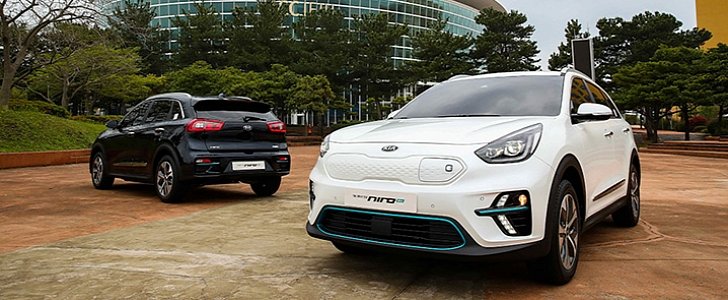Being related to the Hyundai Ioniq, it was a matter of time until Kia leveled up the Niro from Hybrid to Plug-In Hybrid, and then to Electric. The third member of the Niro family is now official, quoted to travel 380 kilometers (236 miles) per charge.
Exhibited at the 5th International Electric Vehicle Expo in South Korea alongside the Niro Plug-In Hybrid and Soul EV, the Niro EV is different from the concept revealed in January at CES 2018. From the standpoint of design, the electric crossover differs from the other two levels of electrification by means of front and rear bumpers, headlights, front grille, and arrowhead-shaped daytime running lights.
The charging port, as you can tell from the featured photo, is located on the driver’s side of the tiger-nose grille. In a similar fashion to the Hyundai Kona Electric, the Niro EV is available with battery capacities: 64 kWh for the range mentioned in the first paragraph of the story and 39.2 kWh for 240 kilometers (149 miles) per charge.
4,375 millimeters long and 1,805 millimeters wide, the Niro EV has a wheelbase of 2,700 millimeters. Coming as standard with 17-inch wheels, the subcompact crossover is equipped with an extensive range of safety systems, including frontal collision avoidance assistance, lane departure assistance, smart cruise control, and rear collision warning. All in all, it’s not bad at all when compared to the Soul EV.
With the Niro EV, “Kia Motors' position in the [electric vehicle] market will further solidify.” To this statement, senior vice-president Ki-Sang Lee added that the automaker “doesn’t believe that there is any ‘silver bullet’ that can satisfy the demand for low-emission technology within the car industry, so we foresee a wide range of eco-friendly powertrains co-existing for an extended period of time.”
No later than 2020, Kia will launch a fuel-cell vehicle with know-how from the Hyundai Nexo. Hyundai and Kia aim to raise the average fuel economy of their vehicles by 25 percent by 2020 to meet emissions regulation in South Korea, the United States, and Europe.
The charging port, as you can tell from the featured photo, is located on the driver’s side of the tiger-nose grille. In a similar fashion to the Hyundai Kona Electric, the Niro EV is available with battery capacities: 64 kWh for the range mentioned in the first paragraph of the story and 39.2 kWh for 240 kilometers (149 miles) per charge.
4,375 millimeters long and 1,805 millimeters wide, the Niro EV has a wheelbase of 2,700 millimeters. Coming as standard with 17-inch wheels, the subcompact crossover is equipped with an extensive range of safety systems, including frontal collision avoidance assistance, lane departure assistance, smart cruise control, and rear collision warning. All in all, it’s not bad at all when compared to the Soul EV.
With the Niro EV, “Kia Motors' position in the [electric vehicle] market will further solidify.” To this statement, senior vice-president Ki-Sang Lee added that the automaker “doesn’t believe that there is any ‘silver bullet’ that can satisfy the demand for low-emission technology within the car industry, so we foresee a wide range of eco-friendly powertrains co-existing for an extended period of time.”
No later than 2020, Kia will launch a fuel-cell vehicle with know-how from the Hyundai Nexo. Hyundai and Kia aim to raise the average fuel economy of their vehicles by 25 percent by 2020 to meet emissions regulation in South Korea, the United States, and Europe.























